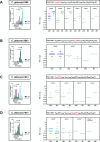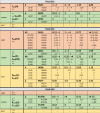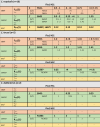In vitro activity of ibrexafungerp against clinically relevant echinocandin-resistant Candida strains
- PMID: 38206004
- PMCID: PMC10848775
- DOI: 10.1128/aac.01324-23
In vitro activity of ibrexafungerp against clinically relevant echinocandin-resistant Candida strains
Abstract
Invasive candidiasis is a major hospital-acquired infection. Usually, echinocandins are considered first-line treatment. However, resistant phenotypes have emerged. Ibrexafungerp (IBX) is a new antifungal substance with potent anti-Candida activity. We challenged IBX with a library of 192 pheno-/genotypically echinocandin-resistant Candida isolates, focusing on the substance susceptibility, its activity on certain FKS hotspot (HS) mutated strains, and applying WTULs (wild-type upper limits). Therefore, a 9-year-old strain and patient data collection provided by the German National Reference Center for Invasive Fungal Infections were analyzed. Species identification was confirmed through ITS-sequencing. Molecular susceptibility testing was performed by sequencing HS of the FKS gene. Anidulafungin (AND) and IBX EUCAST-broth-microdilution was conducted. The four most common echinocandin-resistance mediating mutations were found in Candida glabrata [112/192 isolates; F659-(43×) and S663-(48×)] and Candida albicans [63/192 isolates; F641-(15×) and S645-(39×)]. Mutations at the HS-start sequence were associated with higher IBX MIC-values (F659 and F641 (MIC 50/90 mg/L: >4/>4 and 2/4 mg/L) in comparison to AND (F659 and F641 (MIC 50/90: 1/4 and 0.25/1 mg/L). MIC-values in HS-center mutations were almost equal [MIC50/90 in S663: 2/4 (AND and IBX); in S645: 0.5/1 (AND) and 0.25/1 (IBX) mg/L]. In total, 61 vs 78 of 192 echinocandin-resistant isolates may be classified as IBX wild type by applying WTULs, whereas the most prominent effect was seen in C. albicans [48% (30/63) vs 70% (44/63)]. IBX shows in vitro activity against echinocandin-resistant Candida and thus is an addition to the antifungal armory. However, our data suggest that this effect is more pronounced in C. albicans and strains harboring mutations, affecting the HS-center.
Keywords: Candida; anidulafungin; antifungal agents; antifungal susceptibility testing; echinocandin resistance; ibrexafungerp; invasive candidiasis; new antifungals.
Conflict of interest statement
The authors declare no conflict of interest.
Figures




Similar articles
-
In Vitro Activity of Ibrexafungerp (SCY-078) against Candida auris Isolates as Determined by EUCAST Methodology and Comparison with Activity against C. albicans and C. glabrata and with the Activities of Six Comparator Agents.Antimicrob Agents Chemother. 2020 Feb 21;64(3):e02136-19. doi: 10.1128/AAC.02136-19. Print 2020 Feb 21. Antimicrob Agents Chemother. 2020. PMID: 31844005 Free PMC article.
-
Accuracy of Sensititre YeastOne echinocandins epidemiological cut-off values for identification of FKS mutant Candida albicans and Candida glabrata: a ten year national survey of the Fungal Infection Network of Switzerland (FUNGINOS).Clin Microbiol Infect. 2018 Nov;24(11):1214.e1-1214.e4. doi: 10.1016/j.cmi.2018.05.012. Epub 2018 Jun 15. Clin Microbiol Infect. 2018. PMID: 29909005
-
In vitro activity of ibrexafungerp against Candida species isolated from blood cultures. Determination of wild-type populations using the EUCAST method.Clin Microbiol Infect. 2022 Jan;28(1):140.e1-140.e4. doi: 10.1016/j.cmi.2021.09.030. Epub 2021 Oct 4. Clin Microbiol Infect. 2022. PMID: 34619396
-
Candida and candidaemia. Susceptibility and epidemiology.Dan Med J. 2013 Nov;60(11):B4698. Dan Med J. 2013. PMID: 24192246 Review.
-
Resistance in human pathogenic yeasts and filamentous fungi: prevalence, underlying molecular mechanisms and link to the use of antifungals in humans and the environment.Dan Med J. 2016 Oct;63(10):B5288. Dan Med J. 2016. PMID: 27697142 Review.
Cited by
-
Ibrexafungerp: A narrative overview.Curr Res Microb Sci. 2024 May 27;6:100245. doi: 10.1016/j.crmicr.2024.100245. eCollection 2024. Curr Res Microb Sci. 2024. PMID: 38873590 Free PMC article. Review.
-
The evolution of antifungal therapy: Traditional agents, current challenges and future perspectives.Curr Res Microb Sci. 2025 Jan 11;8:100341. doi: 10.1016/j.crmicr.2025.100341. eCollection 2025. Curr Res Microb Sci. 2025. PMID: 39897698 Free PMC article. Review.
-
Comparative Analysis of the Aspergillus fumigatus Cell Wall Modification and Ensuing Human Dendritic Cell Responses by β-(1,3)-Glucan Synthase Inhibitors-Caspofungin and Enfumafungin.Mycopathologia. 2024 Sep 20;189(5):86. doi: 10.1007/s11046-024-00894-7. Mycopathologia. 2024. PMID: 39302505
References
-
- Geneva WHO . 2022. WHO fungal priority pathogens list to guide research, development and public health action
-
- Andreas H. G, Dieter B, Werner H, Romuald B. 2020. Diagnosis and therapy of Candida infections: joint recommendations of the german speaking mycological society and the Paul-Ehrlich-society for chemotherapy. AWMF online - PubMed
Publication types
MeSH terms
Substances
Grants and funding
LinkOut - more resources
Full Text Sources

